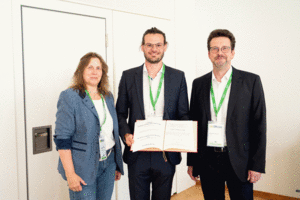

The companies TANIOBIS (formerly: HC Starck Tantalum & Niobium) and HC Starck Tungsten alternately sponsor the prize for an outstanding dissertation in the field of inorganic solid-state chemistry and materials research. The prize is awarded annually by the Division of Solid-State Chemistry & Materials Research of the German Chemical Society (GDCh). The award includes a certificate and prize money of 5,000 euros.
Deadline: April 30, 2026
Objective
The PhD Award is sponsored by TANIOBIS GmbH and is usually awarded every two years by the Division of Solid-State Chemistry & Materials Research of the German Chemical Society (GDCh) for the best doctoral thesis in the field of solid-state chemistry and materials research .
The price
The award includes a certificate and prize money of €5,000 donated by the company TANIOBIS. The prize will be awarded at the GDCh Conference on Inorganic Chemistry, which will take place in Jena from September 7 to 9, 2026. The awardee will be invited to present their award-winning work in a short lecture. The conference fees will be covered by the Division . A panel of experts Division conference by the Division Board will decide on the award. The prize may be shared.
Nominations
Nominations may be submitted by the respective academic supervisor. The dissertation must have been submitted between May 1, 2025, and April 30, 2026. The informal application must include a justification for the nomination (including the nominee's contact information) and the dissertation itself. A list of publications, conference presentations, invited lectures, and similar achievements should also be included.
submission
Please send your nomination electronically, summarized in a single PDF file, to the GDCh Office, addressed to Maike Fries.
The TANIOBIS PhD Award 2024 for solid-state chemistry and materials research was awarded to Dr. Janine Richter on the occasion of the GDCh Conference on Inorganic Chemistry on September 17, 2024 in Munich:
"In recognition of her outstanding dissertation, written in the working group of Prof. Dr. Michael Ruck at the Technical University of Dresden with the title: "Ionometallurgy for low-temperature metal synthesis from metal oxides". In her dissertation, Dr. Richter describes a new approach to the sustainable extraction of elemental metals from primary and secondary raw materials. In the process she scientifically analyzed and optimized, metal oxides of various types are dissolved in a special ionic liquid at moderate temperatures and then electrochemically deposited directly from these solutions. Since the ionic liquid is neither thermally nor chemically impaired, it can be reused. The overall process results in an impressively simple and environmentally friendly balance: metal oxide becomes metal and oxygen. Dr. Richter thus impressively demonstrates the potential of the ionometallurgical approach as a resource- and energy-efficient alternative to conventional metallurgical processes and lays the foundation for a disruptive innovation."

The HC Starck Tungsten PhD Award 2023 for solid-state chemistry and materials research was awarded to Dr. Stephan Müssig on the occasion of the GDCh Science Forum Chemistry on September 4, 2023 in Leipzig.
"in recognition of his outstanding dissertation entitled "Development of suitable supraparticles as magnetic identification features" written in the working group of Prof. Dr. Karl Mandel at the Friedrich-Alexander University Erlangen-Nuremberg for the pioneering contributions described therein to the synthesis of complex magnetic particles and their ensemble fingerprint detection by means of magnetic particle spectroscopy, which can be used, among other things, for magnetism-based recording of temperatures."
The TANIOBIS PhD Award for solid-state chemistry and materials research was awarded to Dr.-Ing Janett Schmelzer and Dr. Nicolas Zapp at the 21st Lecture Conference for Inorganic Chemistry on September 28, 2022 in Marburg.
Dr.-Ing. Janett Schmelzer "in recognition of her outstanding dissertation written at the Otto von Guericke University Magdeburg entitled "Microstructure and properties of powder metallurgical manufactured V-rich V-Si-B alloys for high-temperature application". In her dissertation, Dr. Schmelzer describes a novel approach to the representation of various alloy variants of vanadium-based multiphase materials. By combining mechanical alloying with additive manufacturing in the form of laser cladding and selective laser beam melting in the powder bed, Dr. Schmelzer was able to represent, consolidate and fully characterize unknown vanadium/silicon/boron composites that were previously inaccessible by other means. The work, supported by numerical simulations, represents an outstanding contribution to the development of new high-temperature materials and to improving the thermodynamic efficiency of gas turbines and opens up possibilities that go beyond those of nickel-based superalloys."
Dr. Nicolas Zapp "in recognition of his outstanding dissertation written at the University of Leipzig entitled "Rare Earth Heteroanionic Hydrides with Secondary O 2 –, F –, and N 3 – Ions Related to the CaF 2 and K 2 NiF 4 Structure Types". In his dissertation, Dr. Zapp describes the synthesis of complex heteroanionic compounds of the rare earth elements. The hydride ion plays a crucial role here, which can be substituted by the similarly sized oxide, nitride and fluoride ions. He develops suitable synthesis routes and, by combining analytical methods, succeeds in accurately determining the positions of the anions in the solids. In particular, the combination of X-ray and neutron diffraction leads to high-quality structure determinations. Dr. Zapp thus makes a significant contribution to our understanding of a very new class of substances. The derivation of structure-property relationships through knowledge of the exact The design is supported by high-level theoretical investigations. It is expected that the results will inspire further work on this class of substances, leading to novel materials with previously unforeseeable properties."
The HC Starck Tungsten PhD Award, donated by HC Starck Tungsten GmbH, for solid-state chemistry and materials research was awarded to Dr. Lukas Mai and Dr. Philip Netzsch on the occasion of the GDCh Science Forum Chemistry 2021.
Dr. Lukas Mai in recognition of his outstanding dissertation entitled: “Investigation of Amino-Alkyl Coordinated Complexes as New Precursor Class for Atomic Layer Deposition of Aluminum, Tin and Zinc Oxide Thin Films and their Application” for the pioneering contributions described therein to the development of a new class of precursors for the deposition of atomic layers of binary metal oxides, in particular aluminum oxide, at low temperatures. The dissertation was written in the working group of Prof. Dr. Anjana Devi at the Ruhr University Bochum.
Dr. Philip Netzsch in recognition of his outstanding dissertation entitled: “On Silicate-Analogous Materials – Synthesis and Characterisation of Novel Borosulfates” for the pioneering contributions described therein to the systematic development of a large number of new borosulfates, the rationalisation of the synthetic approach and the investigation of fascinating structure-property relationships. The dissertation was written in the working group of Prof. Dr. Henning A. Höppe at the University of Augsburg.
The TANIOBIS PhD Award (formerly: HC Starck Tantalum & Niobium PhD Award Prize) for solid-state chemistry and materials research was given to OnlinePascal Cop awarded in recognition of his outstanding dissertation with the title: ?CeO 2 -based nanostructures as model catalysts for HCl oxidation?. Dr. Cop's creative, in-depth and future-oriented work on CeO 2 -based nanostructures represents excellent basic research and at the same time addresses a very topical and socially relevant topic, namely the maximization of the efficiency of chemical reactions, which, for example, enable efficient exhaust gas cleaning and are indispensable in large-scale industry. The HCl oxidation plays a very important role from an environmental point of view. Dr. Cop's investigations into the deactivation of the catalyst could in the future contribute to the optimization of catalyst materials for mass technologies and thus to the sustainability of various chemical processes. The dissertation was carried out in the working group of Prof. Dr. Bernd Smarsly at the Justus Liebig University in Gießen .
The HC Starck Tungsten PhD award 2019 for Solid-State Chemistry and Materials Research research was given in equal parts to Dr. Heidi Schwartz and Dr. Simon Kloß forgive.
Dr. Heidi Annemarie Schwartz received the award for her outstanding dissertation on the topic of "Metal-Organic Frameworks as Crystalline Porous Hosts for Photoactive Molecules" and for the pioneering work on structure-property relationships of organometallic framework compounds as crystalline, porous host structures for photoactive molecules.
Dr. Simon David Kloß was recognized for his outstanding dissertation on " The High-Pressure Metathesis Route for the Preparation of Rare-Earth and Transition Metal Nitridophosphates " and for the pioneering discoveries in the field of rare earth and transition metal nitridophosphates as well as for the development of a groundbreaking one new method of high pressure metathesis to open up new areas in nitridophosphate chemistry.
| Year | awardee | affiliation at the time of award | PhD Award |
| 2024 | Dr. Janine Richter | Technical University of Dresden | TANIOBIS |
| 2023 | Dr. Stephan Müssig | Friedrich-Alexander University Erlangen-Nuremberg | HC Starck Tungsten |
| 2022 | Dr.-Ing. Janett Schmelzer Dr. Nicolas Zapp | Otto von Guericke University Magdeburg University of Leipzig | TANIOBIS |
| 2021 | Dr. Lukas Mai Dr. Philip Netzsch | Ruhr University Bochum University of Augsburg | HC Starck Tungsten |
| 2020 | Dr. Pascal Cop | Justus Liebig University Gießen | TANIOBIS |
| 2019 | Dr. Simon David Kloß Dr. Heidi Annemarie Schwartz | Ludwig Maximilian University of Munich University of Cologne | HC Starck Tungsten |
| 2018 | Dr. Sebastian Bette Dr. Chia-Chin Chen | Technical University of Bergakademie Freiberg University of Stuttgart | HC Starck Tantalum & Niobium |
| 2016 | Dr. Martin Heise Dr. Martin Oschatz |
Technical University of Dresden Technical University of Dresden |
HC Starck |
| 2014 | Dr. Pascal Hartmann Dr. Michael Schöneich |
Justus Liebig University Gießen Technical University of Dresden |
HC Starck |
| 2012 | Dr. Matthias Kellermeier Dr. Saskia Stegmaier |
University of Regensburg Technical University of Munich |
HC Starck |
| 2010 | Dr. Bernhard Wahl | Technical University of Dresden | HC Starck |
| 2008 | Dr. Florian M. Stadler | Ludwig Maximilian University of Munich | HC Starck |
| 2006 | Dr. Martin Wilkening | University of Hanover | HC Starck |
| 2004 | Dr. Stefan Schlüter | Rheinische Friedrich-Wilhelms-University Bonn | HC Starck |
| 2002 | Dr. Anja Verena Mudring | Rheinische Friedrich-Wilhelms-University Bonn | HC Starck |
| 2000 | Dr. Hubert Huppertz Dr. Andreas Leineweber Dr. Ulrich Steinbrenner |
Ludwig Maximilian University of Munich |
HC Starck |
| 1997 | Dr. Matthias Conrad Dr. Ingrid Denk |
Philips University of Marburg |
HC Starck |
1995 | Dr. Claus Feldmann Dr. Frank Thomas Lange | Rheinische Friedrich-Wilhelms-University Bonn | HC Starck |
This page has been machine translated. If you have any feedback or comments please feel free to contact us. 
last modified: 01.12.2025 16:29 H from Translator